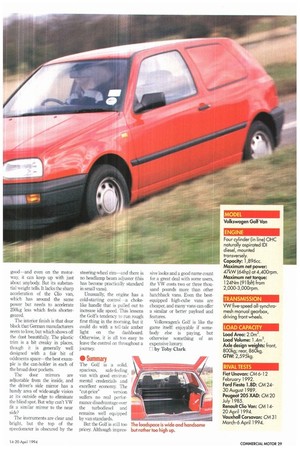VW GOLF VAN
Page 34

Page 35

If you've noticed an error in this article please click here to report it so we can fix it.
Price as tested: £9,075 (ex-VAT). Engine: 1.9 litres, 47kW (64hp). GVW: 1,595kg. Payload: 51 Okg, Fuel consumption (laden): 5.71i0 00km (49.5mpg).
poor old Germany! As the
strength of the Deutschmark pushes up the price of exports, the Economic Miracle threatens to disappear like a bratwurst in a beergarden. Fortunately, Volkswagen has swallowed its pride and admitted that its vehicles won't sell themselves. It has introduced a low-priced, wellequipped version of the Transporter and a naturally aspirated Golf Van which replaces the limwelt turbodiesel version and costs around £.800 less.
CM had the earlier model on long-term test, and enjoyed over 30,000km of trouble-free, comfortable motoring. Our only gripes concerned a lack of refinement in stop-start driving and a broken glovebox lid. With 55kW (75hp) it was ideal for effortless long-distance travel.
In the superseded model, the turbocharger was there primarily to cut emissions rather than to boost power. But how would the cheaper model compare, with 15% less power and 18% less torque? And, most importantly, is it cheap enough?
• Productivity
The laden fuel consumption of the new Golf was a respectable 5.714/100km (49.5mpg) round CM's Kent route, marginally better than that of the turbodiesel, at a fair average speed of 68.6km/h (42.6mph). Unladen (and on a fine, still day) it turned in a tremendous 4.71it/1001cm
(60.3mpg), just a gnat's whisker away from the record set back in 1985 by the Peugeot 205 XADand all the better because the VW is fitted with a catalyst.
Hatchbacks are never as easy to load and unload as a purpose-built van. The Golf proves the point. Its loading lip is around 700mm from the ground, so making use of the full 510kg payload could be hard work.
The Golf is quite a broad vehicle and its load bed is a maximum of 1.47m wide, but the width between wheel arches is only 955mm, somewhat less than competitors such as the new Clio van. At least the load floor is flat, though it lacks any tie-down points. The Golf has the customary half-height bulkhead—some users might want the added security of a mesh upper guard.
• On the road
The Golf has a formidable reputation as a passenger vehicle, and it is easy to assume that it will be a cut above other hatchback vans in road behaviour. But it was unlucky enough to come up against a couple of new vans that combined good ride characteristics with excellent handling.
The mass of the Golf is bound to improve its ride, and sure enough it is smooth, particularly on fast A-roads and motorways. As with many German vehicles, there is a fair bit of tyre noise on British roads. The seats are reasonably comfortable and the driving position is good, though at urban speeds, vibration from the engine is prominent and sets the dashboard rattling.
The unfashionably thin rimmed wheel operates power-assisted steering, which comes as standard. This is welcome around town, but is rather over-light for the motorway. The Golf isn't the most stable of vans in a crosswind, and can feel rather twitchy at speed. Fast B-road driving is helped by fat 165/70 tyres, though there's enough body roll to limit the desirable cornering speed.
The naturally aspirated engine loses nothing to the turbodiesel in urban performance— midrange torque is particularly good—and even on the motorway, it can keep up with just about anybody. But its substantial weight tells. It lacks the sharp acceleration of the Clio van, which has around the same power but needs to accelerate 250kg less which feels shortergeared.
The interior finish is that dour black that German manufacturers seem to love, but which shows off the dust beautifully. The plastic trim is a bit creaky in places, though it is generally well designed with a fair bit of oddments space--the best example is the can-holder in each of the broad door pockets.
The door mirrors are adjustable from the inside, and the driver's side mirror has a handy area of wide-angle vision at its outside edge to eliminate the blind spot. But why can't VW fit a similar mirror to the near side?
The instruments are clear and bright, but the top of the speedometer is obscured by the steering-wheel rim—and there is no headlamp beam adjuster (this has become practically standard in small vans).
Unusually, the engine has a cold-starting control a chokelike handle that is pulled out to increase idle speed. This lessens the Golf's tendency to run rough first thing in the morning, but it could do with a tell-tale amber light on the dashboard. Otherwise, it is all too easy to leave the control on throughout a journey, • Summary The Golf is a solid, spacious, safe-feeling van with good environ-' mental credentials and excellent economy. The "cut-price" version suffers no real performance disadvantage over the turbodiesel and remains well equipped by van standards.
But the Golf is still too pricey Although impres
sive looks and a good name count for a great deal with some users. the VW costs two or three thousand pounds more than other hatchback vans. Even the bestequipped high-cube vans are cheaper, and many vans can offer a similar or better payload and features.
Volkswagen's Golf is like the game itself: enjoyable if somebody else is paying, but otherwise something of an expensive luxury.
IT by Toby Clark


























































































